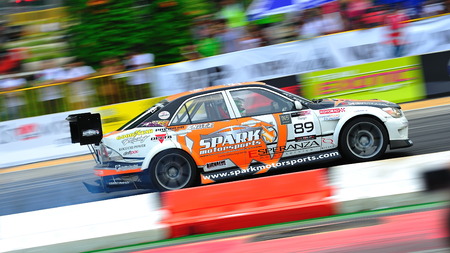Origins of the BTCC and Early Years
The British Touring Car Championship (BTCC) traces its roots back to 1958, a significant year that marked the birth of one of the UKs most beloved motorsport series. Emerging in post-war Britain, the championship was conceived during a period when the nation’s passion for motoring was experiencing a remarkable resurgence. The automotive industry was booming, and there was an increasing appetite among manufacturers and fans alike to see everyday cars tested on racetracks across the country.
Founding of the Championship
The BTCC was originally established as the British Saloon Car Championship (BSCC). Its primary aim was to create a competitive platform for production-based saloon cars, allowing both manufacturers and privateers to participate. The format was straightforward: drivers raced in cars that closely resembled those seen on UK roads, making the sport highly relatable and accessible for spectators.
Original Format of the BSCC
| Year | Name | Car Classes |
|---|---|---|
| 1958 | British Saloon Car Championship | Four classes based on engine size |
This multi-class structure enabled a wide variety of vehicles to compete together, creating close racing action and encouraging participation from numerous brands. Each class winner contributed points towards the overall championship, ensuring that excitement ran throughout the entire field.
The Motorsport Context of Post-War Britain
In the late 1950s, motorsport in Britain was thriving, with legendary circuits such as Silverstone and Brands Hatch gaining popularity. The introduction of the BSCC added a new dimension to UK racing by highlighting cars familiar to everyday Britons. This approach not only boosted fan engagement but also allowed car manufacturers to showcase their engineering prowess under demanding race conditions—an effective marketing strategy in an era where owning a reliable family car was part of the British dream.
2. Growth and Golden Era
The 1960s and 1970s marked a transformative period for the British Touring Car Championship (BTCC), as the championship surged in popularity and firmly established itself as a staple of British motorsport culture. This era witnessed intense competition, the emergence of iconic drivers, and an influx of legendary vehicles that would shape the BTCC’s identity for decades to come.
Iconic Cars That Defined an Era
During this golden age, manufacturers saw the BTCC as an ideal platform to showcase their engineering prowess and boost sales. The grids featured a diverse array of saloon cars that became household names across Britain. Some of the most memorable models included:
| Car Model | Manufacturer | Era Highlights |
|---|---|---|
| Ford Lotus Cortina | Ford | Dominated mid-1960s, renowned for agility and speed |
| Mini Cooper S | BMC | Punching above its weight with nimbleness and reliability |
| BMW 3.0 CSL | BMW | Brought European flair to late 1970s competitions |
| Capri RS2600/RS3100 | Ford | A fan-favourite with aggressive styling and power |
| Vauxhall Magnum | Vauxhall | A homegrown contender making waves in the field |
Legendary Drivers and Fierce Rivalries
The BTCC’s growth during these decades was fuelled by charismatic personalities who became household names. Jim Clark, Jack Sears, Frank Gardner, and Win Percy, among others, thrilled crowds with their skill behind the wheel. Their fierce on-track rivalries added drama and excitement, helping to draw ever-larger crowds to circuits such as Brands Hatch, Silverstone, and Oulton Park.
Cultural Impact in Britain
The BTCC quickly became a Saturday afternoon television favourite, captivating audiences across the country. Its accessible format—showcasing cars similar to those found on British roads—helped fans relate to the action and fostered passionate brand loyalties. The championship’s profile also benefitted from increased media coverage, sponsorship deals, and manufacturer investment, setting the stage for its enduring legacy.

3. Technical Evolution and Rule Changes
The British Touring Car Championship (BTCC) has seen remarkable technical evolution and a series of rule changes since its inception in 1958, each shaping the competition’s character and appeal. In its early years, the BTCC was defined by a relatively simple set of regulations, allowing production saloon cars to compete with minimal modifications. However, as the championship grew in stature and manufacturers began to see its marketing potential, both vehicle technology and regulations underwent significant transformation.
Key Technical Innovations
The introduction of fuel injection systems, turbocharging, and advanced aerodynamics marked pivotal moments in BTCC history. Notably, the 1990s ‘Super Touring’ era brought about highly sophisticated engineering solutions—teams invested heavily in lightweight materials, advanced suspension systems, and powerful engines. These innovations elevated performance but also led to soaring costs.
Manufacturer Involvement
Major car manufacturers such as Ford, Vauxhall, Honda, BMW, and Toyota became deeply involved during the Super Touring era. Their participation not only increased the technological stakes but also heightened public interest. This influx of investment prompted the need for regulatory intervention to maintain competitive balance and control expenses.
Changing Vehicle Regulations: An Overview
| Era | Main Regulation | Key Impact |
|---|---|---|
| 1958-1986 | Group 2 & Group A rules | Promoted production-based racing; limited modifications |
| 1991-2000 | Super Touring regulations | High-tech advancements; escalating costs; increased manufacturer involvement |
| 2001-2010 | BTC Touring/Production rules | Cost reduction; more privateer entries; simplified tech |
| 2011-present | NGTC (Next Generation Touring Car) | Sustainable costs; parity between teams; competitive grids |
The adoption of NGTC regulations in 2011 was particularly transformative for the modern BTCC. By standardising key components such as suspension, brakes, and gearboxes, organisers enabled smaller teams to compete on a more level playing field with factory-backed outfits. This change reinvigorated grid sizes and fostered a closer, more unpredictable racing spectacle that remains popular with UK fans today.
4. The Super Touring Era
The 1990s marked a golden era for the British Touring Car Championship (BTCC), widely celebrated as the Super Touring Era. This period saw an explosion in both popularity and competitiveness, as international stars flocked to the grid and manufacturers invested heavily in advanced technology. The racing spectacle was heightened by fierce rivalries, technical innovation, and close-fought battles that captured the imagination of fans across the UK and beyond.
International Stars and Manufacturer Showdowns
The Super Touring regulations, adopted in 1990, created a level playing field that attracted major car manufacturers such as Ford, Vauxhall, BMW, Renault, Nissan, and Honda. Their commitment brought not only advanced engineering but also big-name drivers from around the world. Household names like Alain Menu, John Cleland, Rickard Rydell, and Jason Plato became regular contenders for the championship title.
Key Manufacturers and Their Iconic Cars
| Manufacturer | Model | Notable Achievements |
|---|---|---|
| Renault | Laguna | Dominant in late 1990s, Alain Menu’s 1997 title win |
| Volvo | 850 Estate & S40 | Famous for innovative estate car entry; Rydell’s consistent podiums |
| Ford | Mondeo | Championship victory with Alain Menu in 2000 |
| Nissan | Primera | Larry Hoy’s team led David Leslie to 1999 title glory |
| Vauxhall | Cavalier & Vectra | Pivotal in manufacturer rivalry throughout the decade |
The Global Influence of Super Touring Cars
The appeal of BTCC’s Super Touring formula quickly spread internationally. Similar regulations were adopted by touring car championships in Germany (DTM), Australia (Super Touring), and Italy (CIVT), establishing a global standard for touring car competition. The British series stood at the heart of this movement, influencing motorsport design and engineering far beyond its borders.
A Lasting Legacy on British Motorsport Culture
The Super Touring Era is fondly remembered by UK fans for its thrilling on-track action, packed grandstands, and extensive media coverage. It set new benchmarks for professionalism in British motorsport and inspired a generation of enthusiasts who continue to follow BTCC today. Although rising costs eventually prompted regulatory changes at the turn of the millennium, the legacy of this iconic era lives on through historic events and restored cars that grace circuits around Britain.
5. Modern BTCC and Its Legacy
The British Touring Car Championship (BTCC) has continued to thrive in the 21st century, adapting to new regulations, embracing technological innovation, and deepening its connection with fans. The modern BTCC remains a cornerstone of British motorsport, both reflecting and shaping the nation’s racing culture.
Contemporary Regulations and Technological Advancements
The current era of BTCC is defined by its adoption of the NGTC (Next Generation Touring Car) regulations, introduced in 2011. These rules standardise key components such as suspension, brakes, and gearboxes, making racing more competitive while keeping costs manageable for teams. The series also focuses on sustainability, incorporating hybrid technology to reduce environmental impact without sacrificing excitement on the track.
| Regulation | Purpose | Impact |
|---|---|---|
| NGTC | Standardises major components | Level playing field, reduced costs |
| Hybrid Technology | Reduces emissions | Modernises championship, eco-friendly focus |
| Success Ballast | Adds weight to successful drivers | Keeps championship competitive |
Fan Engagement in the Digital Age
The BTCC has embraced digital platforms to engage a broader audience. Live broadcasts on ITV4 bring every race weekend into homes across the UK, while social media channels allow fans to interact with drivers and teams directly. The paddock remains famously accessible, with open autograph sessions and pit walks giving supporters a chance to get close to their heroes—something that sets BTCC apart from many other top-tier motorsport series.
Key Ways Fans Engage with Modern BTCC:
- Live TV broadcasts and online streaming
- Active social media communities on Twitter, Instagram, and Facebook
- Paddock access during race weekends for immersive experiences
- Official merchandise and interactive fan zones at circuits
The Ongoing Impact on British Motorsport Culture
The BTCC continues to play a vital role in nurturing homegrown talent and providing a platform for both established names and rising stars. Its multi-marque grid reflects the diversity of the UK’s automotive industry, ensuring broad appeal among car enthusiasts. Moreover, the championship’s enduring popularity keeps grassroots motorsport alive, inspiring new generations of drivers and fans alike.
BTCCs Cultural Legacy Includes:
- A tradition of close racing and sportsmanship that defines British touring car competition
- A proving ground for future international racing talent from the UK
- An iconic presence in British sporting life, frequently referenced in popular media and community events
- Sustained support for British circuits and local economies through annual race meetings nationwide
The modern BTCC stands as a testament to adaptability and enduring appeal—balancing heritage with innovation. Its legacy continues not only on track but also in its influence on British motorsport culture, ensuring that it remains an integral part of the nation’s sporting identity for years to come.


